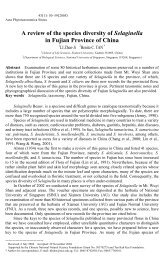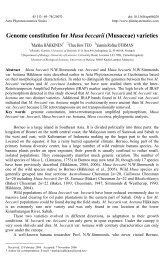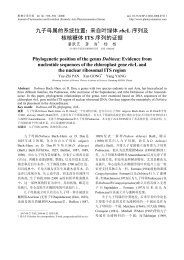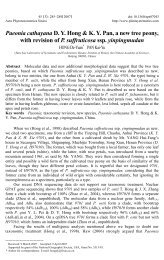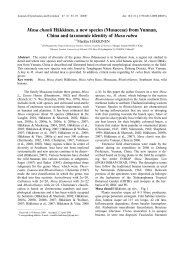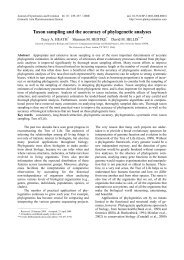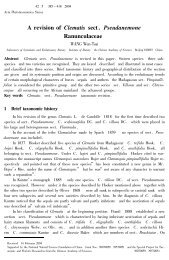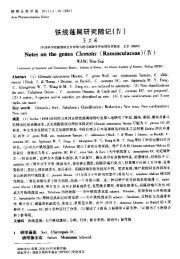Low genetic diversity and high genetic differentiation in the critically ...
Low genetic diversity and high genetic differentiation in the critically ...
Low genetic diversity and high genetic differentiation in the critically ...
Create successful ePaper yourself
Turn your PDF publications into a flip-book with our unique Google optimized e-Paper software.
Journal of Systematics <strong>and</strong> Evolution 47 (2): 103–109 (2009) doi: 10.1111/j.1759-6831.2009.00008.x<br />
<strong>Low</strong> <strong>genetic</strong> <strong>diversity</strong> <strong>and</strong> <strong>high</strong> <strong>genetic</strong> <strong>differentiation</strong> <strong>in</strong> <strong>the</strong> <strong>critically</strong><br />
endangered Omphalogramma souliei (Primulaceae):<br />
implications for its conservation<br />
Yuan HUANG Chang-Q<strong>in</strong> ZHANG De-Zhu LI *<br />
(Key Laboratory of Bio<strong>diversity</strong> <strong>and</strong> Biogeography, Kunm<strong>in</strong>g Institute of Botany, Ch<strong>in</strong>ese Academy of Sciences, Kunm<strong>in</strong>g 650204, Ch<strong>in</strong>a)<br />
Abstract Omphalogramma souliei Franch. is an endangered perennial herb only distributed <strong>in</strong> alp<strong>in</strong>e areas of<br />
SW Ch<strong>in</strong>a. ISSR markers were applied to determ<strong>in</strong>e <strong>the</strong> <strong>genetic</strong> variation <strong>and</strong> <strong>genetic</strong> structure of 60 <strong>in</strong>dividuals<br />
of three populations of O. souliei <strong>in</strong> NW Yunnan, Ch<strong>in</strong>a. The <strong>genetic</strong> <strong>diversity</strong> at <strong>the</strong> species level is low with P=<br />
42.5% (percentage of polymorphic b<strong>and</strong>s) <strong>and</strong> Hsp=0.1762 (total <strong>genetic</strong> <strong>diversity</strong>). However, a <strong>high</strong> level of<br />
<strong>genetic</strong> <strong>differentiation</strong> among populations was detected based on different measures (Nei’s <strong>genetic</strong> <strong>diversity</strong><br />
analysis: Gst=0.6038; AMOVA analysis: Fst=0.6797). <strong>Low</strong> level of <strong>genetic</strong> <strong>diversity</strong> with<strong>in</strong> populations <strong>and</strong><br />
significant <strong>genetic</strong> <strong>differentiation</strong> among populations might be due to <strong>the</strong> mixed mat<strong>in</strong>g system <strong>in</strong> which xenogamy<br />
predom<strong>in</strong>ated <strong>and</strong> autogamy played an assistant role <strong>in</strong> O. souliei. The <strong>genetic</strong> drift due to small population<br />
size <strong>and</strong> limited current gene flow also resulted <strong>in</strong> significant <strong>genetic</strong> <strong>differentiation</strong>. The assessment of <strong>genetic</strong><br />
variation <strong>and</strong> <strong>differentiation</strong> of <strong>the</strong> endangered species provides important <strong>in</strong>formation for conservation on a<br />
<strong>genetic</strong> basis. Conservation strategies for this rare endemic species are proposed.<br />
Key words <strong>genetic</strong> <strong>differentiation</strong>, <strong>genetic</strong> <strong>diversity</strong>, ISSR markers, mat<strong>in</strong>g system, Omphalogramma souliei.<br />
More <strong>and</strong> more species have become threatened<br />
or ext<strong>in</strong>ct <strong>in</strong> <strong>the</strong> wild, <strong>and</strong> plant conservations concerned<br />
with rare <strong>and</strong> endangered species are faced<br />
with a daunt<strong>in</strong>g task (Hols<strong>in</strong>ger & Gottlieb, 1991).<br />
The ma<strong>in</strong>tenance of <strong>genetic</strong> variation is one of <strong>the</strong><br />
major objectives for conserv<strong>in</strong>g endangered <strong>and</strong><br />
threatened species (Avise & Hamrick, 1996). For <strong>the</strong><br />
formulation of appropriate management strategies<br />
directed towards conservation, knowledge of <strong>genetic</strong><br />
variation between <strong>and</strong> with<strong>in</strong> populations provides<br />
essential <strong>in</strong>formation (Milligan et al., 1994). Breed<strong>in</strong>g<br />
system is a key factor that affects <strong>the</strong> levels of <strong>genetic</strong><br />
variation <strong>in</strong> species. An important component of<br />
mat<strong>in</strong>g is <strong>the</strong> amount of self-fertilization that a population<br />
experienced. Self<strong>in</strong>g has direct <strong>genetic</strong> consequences,<br />
<strong>in</strong>clud<strong>in</strong>g its effect on <strong>the</strong> <strong>in</strong>tensity of <strong>in</strong>breed<strong>in</strong>g<br />
depression <strong>and</strong> partition<strong>in</strong>g of <strong>genetic</strong> <strong>diversity</strong><br />
with<strong>in</strong> <strong>and</strong> among populations (Barrett et al.,<br />
2004).<br />
Omphalogramma souliei Franch. is a <strong>critically</strong><br />
endangered, perennial herbaceous plant <strong>and</strong> locally<br />
endemic to <strong>the</strong> alp<strong>in</strong>e area <strong>in</strong> SW Ch<strong>in</strong>a. It grows <strong>in</strong><br />
alp<strong>in</strong>e meadows <strong>and</strong> forest marg<strong>in</strong>s at altitudes of<br />
2200–4600 m (Hu & Kelso, 1996). Accord<strong>in</strong>g to our<br />
survey on this species <strong>in</strong> <strong>the</strong> past five years, it is<br />
estimated that no more than 2000 <strong>in</strong>dividuals survived<br />
———————————<br />
Received: 4 July 2008 Accepted: 22 September 2008<br />
* Author for correspondence. E-mail: dzl@mail.kib.ac.cn;<br />
Tel.: +86-871-5223503; Fax: +86-871-5217791.<br />
<strong>in</strong> <strong>the</strong> wild. At present, only three populations were<br />
found <strong>in</strong> our five years survey. More populations of<br />
this species were recorded accord<strong>in</strong>g to herbarium<br />
specimen survey, however, most of <strong>the</strong> populations<br />
have already disappeared <strong>in</strong> <strong>the</strong> last two decades. The<br />
threats to <strong>the</strong> species are related to human activities as<br />
well as destruction of its habitats. In addition, both<br />
population number <strong>and</strong> size are decl<strong>in</strong><strong>in</strong>g at an alarm<strong>in</strong>g<br />
rate <strong>in</strong> <strong>the</strong> last decade, <strong>and</strong> <strong>genetic</strong> <strong>diversity</strong> is<br />
likely to be reduced. Consider<strong>in</strong>g <strong>the</strong> small population<br />
number <strong>and</strong> size <strong>and</strong> limited distribution of this locally<br />
endemic <strong>and</strong> rare species, O. souliei should be<br />
assigned <strong>in</strong> a <strong>high</strong> priority for protection.<br />
Inter-simple sequence repeats (ISSRs), recently<br />
used widely <strong>in</strong> population <strong>genetic</strong> study because of <strong>the</strong><br />
less <strong>in</strong>vestment <strong>in</strong> time, money <strong>and</strong> labour than o<strong>the</strong>r<br />
markers, are <strong>high</strong>ly variable <strong>and</strong> exhibit Mendelian<br />
<strong>in</strong>heritance (Gupta et al., 1994; Tsumura et al., 1996;<br />
Wolfe & Liston, 1998; Harris, 1999). In this study,<br />
ISSR markers were used to detect variation at <strong>the</strong><br />
population level <strong>in</strong> samples collected from NW Yunnan,<br />
Ch<strong>in</strong>a. The purpose of this study is to <strong>in</strong>vestigate<br />
<strong>the</strong> levels of ISSR variation <strong>and</strong> <strong>differentiation</strong> among<br />
O. souliei populations.<br />
In this study, we assessed <strong>the</strong> extent of <strong>genetic</strong><br />
variation with<strong>in</strong> <strong>and</strong> between populations of O. souliei<br />
by ISSR markers. This is part of a project on <strong>the</strong><br />
conservation <strong>genetic</strong>s of O. souliei, <strong>in</strong>volv<strong>in</strong>g studies<br />
on <strong>the</strong> mat<strong>in</strong>g systems, seed dispersal based on <strong>the</strong><br />
observed <strong>genetic</strong> structure. The objectives of our
104<br />
Journal of Systematics <strong>and</strong> Evolution Vol. 47 No. 2 2009<br />
research are to (1) fill <strong>the</strong> important gaps <strong>in</strong> our<br />
knowledge of <strong>the</strong> amount <strong>and</strong> distribution pattern of<br />
<strong>genetic</strong> <strong>diversity</strong> <strong>in</strong> O. souliei <strong>in</strong> relation to its reproductive<br />
biology, seed dispersal mechanisms <strong>and</strong><br />
ecology, (2) answer <strong>the</strong> question whe<strong>the</strong>r species of O.<br />
souliei display low level of <strong>genetic</strong> <strong>diversity</strong>, given<br />
limited population size <strong>and</strong> number, as most endangered<br />
species do; <strong>and</strong> (3) provide basel<strong>in</strong>e <strong>genetic</strong><br />
<strong>in</strong>formation pert<strong>in</strong>ent to <strong>the</strong> conservation <strong>and</strong> restoration<br />
of this rare <strong>and</strong> endemic species.<br />
1 Material <strong>and</strong> methods<br />
1.1 Plant species<br />
Omphalogramma souliei is a perennial herbaceous<br />
plant with a basal rosette of leaves. This species<br />
is endemic to SW Ch<strong>in</strong>a, represent<strong>in</strong>g <strong>the</strong> S<strong>in</strong>o-<br />
Himalayan genus Omphalogramma Franch. Plants are<br />
50–90 cm tall, with funnelform corolla which is deep<br />
red to bluish purple <strong>in</strong> color, stamens <strong>in</strong>sert<strong>in</strong>g <strong>in</strong> <strong>the</strong><br />
middle of <strong>the</strong> corolla tube <strong>and</strong> style exsert<strong>in</strong>g out of<br />
<strong>the</strong> mouth of <strong>the</strong> corolla. Flower<strong>in</strong>g time is from May<br />
to June. The fruits form <strong>in</strong> June to July <strong>and</strong> capsules<br />
are ripe <strong>in</strong> September (Hu & Kelso, 1996).<br />
1.2 Study sites <strong>and</strong> sampl<strong>in</strong>g<br />
Three populations from <strong>the</strong> northwest of Yunnan<br />
prov<strong>in</strong>ce of Ch<strong>in</strong>a were surveyed <strong>and</strong> leaf tissues of<br />
60 <strong>in</strong>dividuals <strong>in</strong> three O. souliei populations were<br />
collected (Table 1). Individuals 2–5 m apart from one<br />
ano<strong>the</strong>r were sampled r<strong>and</strong>omly. Leaves were collected<br />
<strong>in</strong> <strong>the</strong> field <strong>and</strong> dried <strong>in</strong> silica gel. These populations<br />
grow <strong>in</strong> <strong>the</strong> marg<strong>in</strong>s of conifer forest dom<strong>in</strong>anted<br />
by Picea Dietr. <strong>and</strong> Tsuga Carrière, or under<br />
Rhododendron L. thickets, or alp<strong>in</strong>e meadow mixed<br />
with Fragaria L., Lomatogonium A. Braun, etc.,<br />
altitude 3300–3500 m. The sampled populations all<br />
grow <strong>in</strong> <strong>the</strong> marsh. Their habitat represents <strong>the</strong> richly<br />
endowed yet ra<strong>the</strong>r stable primitive environment <strong>in</strong><br />
<strong>the</strong> sampled regions.<br />
1.3 DNA extraction <strong>and</strong> ISSR-PCR amplification<br />
Genomic DNA was extracted us<strong>in</strong>g a modified<br />
CTAB method (Doyle & Doyle, 1987). The DNA was<br />
amplified with PCR us<strong>in</strong>g ISSR primers from University<br />
of British Columbia (UBC). Of 100 ISSR primers,<br />
12 produced clear <strong>and</strong> reproducible b<strong>and</strong>s, <strong>and</strong> were<br />
selected for <strong>the</strong> subsequent experiments (Table 2).<br />
ISSR-PCR amplifications were performed <strong>in</strong> Gene-<br />
Amp PCR System 9700 DNA Thermal Cycler<br />
(Perk<strong>in</strong>Elmer, USA) with <strong>the</strong> cycl<strong>in</strong>g programme: 5<br />
m<strong>in</strong> at 94 °C, followed by 37 cycles of 30 s at 94 °C,<br />
45 s at 52 °C, 90 s at 72 °C, <strong>and</strong> last extention at 72<br />
°C for 7 m<strong>in</strong>. PCR amplification was carried out <strong>in</strong> a<br />
total volume of 25 μL, consist<strong>in</strong>g of 40 ng template<br />
DNA, 2.5 μL 10×PCR buffer, 2 μL MgCl2 (25<br />
mmol/L), 1.0 μL dNTPs (2.5 mmol/L), 2% Forma mide,<br />
0.225 μmol/L primer, 1 U of Taq polymerase (Takara)<br />
<strong>and</strong> double-distilled water. Amplification products<br />
Table 1 Information of three populations of Omphalogramma souliei sampled<br />
Pop. code Sample size Location Position Altitude (m) Size<br />
FSL 20 Fenshuil<strong>in</strong>g, between Lijiang <strong>and</strong> Weixi, Yunnan,<br />
Ch<strong>in</strong>a (云南丽江维西分水岭)<br />
27º13′46.9′′ N, 99º24′10.0′′ E 3370 ~20<br />
LDP 20 Lidip<strong>in</strong>g, Weixi, Yunnan, Ch<strong>in</strong>a (云南维西栗地坪) 27º13′25.9′′ N, 99º24′36.5′′ E 3450 ~1000<br />
GHZ 20 Ganhaizi, Lijiang, Yunnan, Ch<strong>in</strong>a (云南丽江甘海子) 27º14′02.3′′ N, 99º24′34.3′′ E 3480 ~100<br />
Table 2 The sequences of ISSR primers <strong>and</strong> <strong>the</strong> number of amplified loci on Omphalogramma souliei<br />
Primer code Sequence No. of loci No. of polymorphic loci P<br />
2 BDB(TCC)5 6 0 0<br />
9 CCC(GT)6 8 5 62.5<br />
10 BDB(CA)6 9 3 33.3<br />
14 GCG(AC)6 8 5 62.5<br />
808 (AG)8G 6 2 33.3<br />
811 (GA) 8G 7 3 42.9<br />
813 (CT) 8T 7 1 14.3<br />
817 (CA) 8A 8 6 75.0<br />
818 (CA) 8G 6 4 66.7<br />
861 (ACC) 5 8 2 25.0<br />
865 (CCG) 5 9 6 66.7<br />
889 DBD(AD) 7 5 0 0<br />
Total 87 37 42.5
HUANG et al.: <strong>Low</strong> <strong>genetic</strong> <strong>diversity</strong> <strong>and</strong> <strong>high</strong> <strong>genetic</strong> <strong>differentiation</strong> <strong>in</strong> Omphalogramma souliei<br />
were electrophoretically separated on 1.5% agarose<br />
gels with 0.5×TBE buffered. A DNA ladder was<br />
applied as a size marker (100–3000). After sta<strong>in</strong><strong>in</strong>g<br />
with ethidium bromide for 30 m<strong>in</strong>, DNA fragments<br />
were identified by image analysis software for gel<br />
documentation. Only those gel that showed consistent<br />
<strong>and</strong> clear b<strong>and</strong>s were considered; while those smeared<br />
<strong>and</strong> weak were excluded.<br />
1.4 Genetic <strong>diversity</strong> analysis<br />
Because ISSR markers are dom<strong>in</strong>ant, it is assumed<br />
that each b<strong>and</strong> represents at a s<strong>in</strong>gle biallelic<br />
locus (Williams et al., 1990). Amplified fragments<br />
were scored for <strong>the</strong> presence (1) or absence (0) of<br />
homologous b<strong>and</strong>s. The result<strong>in</strong>g presence/absence<br />
data matrix of <strong>the</strong> ISSR phenotypes was analyzed<br />
us<strong>in</strong>g POPGENE version 1.31 (Yeh et al., 1999) to<br />
estimate <strong>the</strong> follow<strong>in</strong>g <strong>genetic</strong> <strong>diversity</strong> parameters at<br />
<strong>the</strong> species level: (1) <strong>the</strong> percentage of polymorphic<br />
b<strong>and</strong>s (P); (2) Nei’s (1972) unbiased expected heterozygosity<br />
(He), He=1-∑Pi 2 , where Pi is <strong>the</strong> mean<br />
frequency of <strong>the</strong> ith ISSR fragment; (3) Shannon’s<br />
<strong>in</strong>dex of phenotypic <strong>diversity</strong> (Ho) (Lewont<strong>in</strong>, 1972).<br />
Ho=-∑Pi log2 Pi, where Pi is <strong>the</strong> frequency of <strong>the</strong> ith<br />
ISSR fragment, is frequently used without <strong>the</strong> need to<br />
make assumptions regard<strong>in</strong>g Hardy-We<strong>in</strong>berg equilibrium<br />
(Fonta<strong>in</strong>e et al., 2004). Shannon’s <strong>in</strong>dices were<br />
calculated for two levels: <strong>the</strong> average <strong>diversity</strong> with<strong>in</strong><br />
population (Hpop) <strong>and</strong> <strong>the</strong> <strong>diversity</strong> with<strong>in</strong> species<br />
(Hsp). Nei’s (1972) <strong>genetic</strong> identity (I) <strong>and</strong> <strong>genetic</strong><br />
distance (D) were calculated for all pairwise comb<strong>in</strong>ations<br />
of populations.<br />
In addition, an analysis of molecular variance<br />
(AMOVA) was applied to estimate variance components<br />
for ISSR phenotypes, partition<strong>in</strong>g <strong>the</strong> variations<br />
among populations <strong>and</strong> among <strong>in</strong>dividuals. The<br />
significance of this F-statistic analogue was tested<br />
with 1000 r<strong>and</strong>om permutations. The <strong>genetic</strong> relatedness<br />
among <strong>the</strong> 60 <strong>in</strong>dividuals of three populations<br />
was analyzed us<strong>in</strong>g Unweighted Pair Group Method<br />
with Arithmetic Average (UPGMA) based on pairwise<br />
Nei’s (1973) <strong>genetic</strong> distance. Bootstrap analysis<br />
us<strong>in</strong>g UPGMA search with 1000 replicates was<br />
performed to obta<strong>in</strong> <strong>the</strong> confidence of <strong>the</strong> tree.<br />
2 Results<br />
105<br />
2.1 Genetic <strong>diversity</strong><br />
In this study, <strong>genetic</strong> <strong>diversity</strong> was exam<strong>in</strong>ed <strong>in</strong><br />
Omphalogramma souliei, based on ISSR f<strong>in</strong>gerpr<strong>in</strong>t<strong>in</strong>g.<br />
Twelve primers that produced clear <strong>and</strong> reproducible<br />
b<strong>and</strong>s were selected for fur<strong>the</strong>r analysis. These<br />
12 selected primers generated totally 87 unambiguous<br />
<strong>and</strong> reproducible electrophoretic b<strong>and</strong>s (loci) that<br />
ranged <strong>in</strong> size from 350 to 2800 bp, with an average of<br />
7.25 b<strong>and</strong>s per primer. Of <strong>the</strong>se b<strong>and</strong>s, 42.53% (37 <strong>in</strong><br />
total) were polymorphic among 60 <strong>in</strong>dividuals. The<br />
percentage of polymorphic b<strong>and</strong>s (PPB) of this species<br />
was 42.53%. The PPB varied greatly <strong>in</strong> s<strong>in</strong>gle<br />
population rang<strong>in</strong>g from 5.75% (LDP) to 26.44% (FSL).<br />
At <strong>the</strong> population level, very few polymorphism<br />
<strong>and</strong> low <strong>diversity</strong> were detected for <strong>the</strong> three populations,<br />
with P: 26.44%, 5.75%, <strong>and</strong> 14.94%, Hpop:<br />
0.1108, 0.0220, <strong>and</strong> 0.0775, He: 0.0697, 0.0132, <strong>and</strong><br />
0.0520 for populations FSL, LDP, <strong>and</strong> GHZ, respectively.<br />
Among <strong>the</strong> three populations exam<strong>in</strong>ed <strong>in</strong> this<br />
study, population FSL possessed <strong>the</strong> smallest size<br />
(~20 <strong>in</strong>dividuals), but ma<strong>in</strong>ta<strong>in</strong>ed <strong>the</strong> <strong>high</strong>est level of<br />
variability (P: 26.44; He: 0.0697; Hpop: 0.1108),<br />
whereas <strong>the</strong> population LDP possessed <strong>the</strong> greatest<br />
size (~1000 <strong>in</strong>dividuals), ma<strong>in</strong>ta<strong>in</strong>ed <strong>the</strong> lowest level<br />
of <strong>genetic</strong> variation (P: 5.75; He: 0.0132; Hpop:<br />
0.0220). Although <strong>the</strong> number of <strong>in</strong>dividuals varied<br />
from 20 to 1000, <strong>genetic</strong> <strong>diversity</strong> is not correlated<br />
with <strong>the</strong> population size (Table 3). At <strong>the</strong> species<br />
level, O. soulei possessed <strong>high</strong> level of <strong>genetic</strong> variation<br />
(P: 42.53; Ht: 0.1135; Hsp: 0.1762).<br />
2.2 Genetic structure<br />
Genetic analysis showed that <strong>the</strong> <strong>high</strong>est identity<br />
(0.9248) existed between populations FSL <strong>and</strong> LDP,<br />
while <strong>the</strong> lowest (0.8402) occurred between populations<br />
FSL <strong>and</strong> GHZ. Most <strong>genetic</strong> variation of O.<br />
souliei was distributed among populations. The <strong>genetic</strong><br />
<strong>differentiation</strong> (Gst) among populations was<br />
estimated to be 0.6038, which <strong>in</strong>dicated that 60.38%<br />
of <strong>the</strong> <strong>genetic</strong> variability was distributed among<br />
populations, <strong>and</strong> only 39.62% of <strong>the</strong> variation existed<br />
with<strong>in</strong> populations. The number of migrants (Nm) was<br />
Table 3 Genetic variability with<strong>in</strong> populations of Omphalogramma souliei revealed by ISSR markers<br />
Population Percentage of polymorphic loci (P) Nei’s <strong>diversity</strong> (He) Shannon <strong>in</strong>dex (Hpop) Gst Nm<br />
FSL 26.44 0.0697 (0.1373) 0.1108 (0.2059)<br />
LDP 5.75 0.0132 (0.0592) 0.0220 (0.0950)<br />
GHZ 14.94 0.0520 (0.1373) 0.0775 (0.1985)<br />
Mean 15.71 0.0497 0.0701<br />
Species level 42.53 0.1135 (0.1698) 0.1762 (0.2490) 0.6038 0.3280
106<br />
Journal of Systematics <strong>and</strong> Evolution Vol. 47 No. 2 2009<br />
Table 4 Nei’s (1972) orig<strong>in</strong>al measures of <strong>genetic</strong> identity (above diagonal) <strong>and</strong> <strong>genetic</strong> distance (below diagonal) between populations of Omphalogramma<br />
souliei<br />
Population FSL LDP GHZ<br />
FSL **** 0.9248 0.8402<br />
LDP 0.0782 **** 0.9146<br />
GHZ 0.1741 0.0892 ****<br />
estimated as 0.3280 <strong>in</strong>dividuals per generation between<br />
populations, <strong>in</strong>dicat<strong>in</strong>g that <strong>the</strong>re is a low<br />
migration rate between populations. Table 4 shows an<br />
estimate of Nei’s <strong>genetic</strong> identities (I) <strong>and</strong> <strong>genetic</strong><br />
distance (D) for every pairwise comparison between<br />
each population pairs. This results show that <strong>the</strong><br />
<strong>high</strong>est <strong>genetic</strong> distance was 0.1741 between populations<br />
FSL <strong>and</strong> GHZ, while <strong>the</strong> lowest (0.0782) occurred<br />
between populations FSL <strong>and</strong> GHZ. The<br />
AMOVA analysis is consistent with <strong>the</strong> results of<br />
Nei’s <strong>genetic</strong> structure that <strong>the</strong>re is <strong>high</strong> degree of<br />
population <strong>differentiation</strong> (Fst=0.6797), where 67.97%<br />
variance was partitioned among populations <strong>and</strong> 32.03%<br />
to <strong>in</strong>dividual differences with<strong>in</strong> populations. A<br />
UPGMA dendrogram (Fig. 1) was reconstructed based<br />
on <strong>the</strong> pairwise <strong>genetic</strong> distance between 60 <strong>in</strong>dividuals<br />
of three populations. The dendrogram showed a<br />
separation of plants <strong>in</strong>to three groups. The first group<br />
(G) consisted of 20 <strong>in</strong>dividuals from population GHZ.<br />
Three clusters were identified, of which, 20 <strong>in</strong>dividuals<br />
of each population were fur<strong>the</strong>r clustered.<br />
3 Discussion<br />
3.1 Genetic <strong>diversity</strong><br />
The results of <strong>the</strong> present study us<strong>in</strong>g ISSR<br />
markers revealed low level of <strong>genetic</strong> <strong>diversity</strong> with<strong>in</strong><br />
populations <strong>and</strong> remarkable <strong>genetic</strong> <strong>differentiation</strong><br />
among populations <strong>in</strong> Omphalogramma souliei.<br />
Population <strong>genetic</strong> <strong>diversity</strong> <strong>in</strong> a species is affected by<br />
a number of evolutionary factors <strong>in</strong>clud<strong>in</strong>g mat<strong>in</strong>g<br />
system, gene flow <strong>and</strong> seed dispersal, geographic<br />
range as well as natural selection (Hamrick & Godt,<br />
1989). Of <strong>the</strong>se factors, <strong>the</strong> geographic range of a<br />
species appears to <strong>in</strong>fluence <strong>the</strong> levels of <strong>genetic</strong><br />
<strong>diversity</strong> with<strong>in</strong> populations greatly.<br />
Omphalogramma souliei is a <strong>critically</strong> endangered<br />
perennial herbaceous plant with limited distribution.<br />
Generally, species with small geographic<br />
range tends to ma<strong>in</strong>ta<strong>in</strong> less <strong>genetic</strong> <strong>diversity</strong> than that<br />
of geographically widespread species (Hamrick &<br />
Godt, 1989). Based on this assumption, a low level of<br />
<strong>genetic</strong> <strong>diversity</strong> with<strong>in</strong> species is expected <strong>in</strong> O.<br />
souliei. Shannon <strong>in</strong>dices <strong>in</strong> <strong>the</strong> three populations of O.<br />
souliei ranged from 0.0220 to 0.1108. These values<br />
were far lower than <strong>the</strong> average of dicotyledons<br />
(0.191) <strong>and</strong> short-lived perennial plants (0.207) (Nybom<br />
& Bartish, 2000). The levels of <strong>genetic</strong> <strong>diversity</strong><br />
of O. souliei are much lower than <strong>the</strong> <strong>genetic</strong> <strong>diversity</strong><br />
reported <strong>in</strong> some wide geographical range species of<br />
<strong>the</strong> genus Primula, a closely related genus of Omphalogramma.<br />
High <strong>genetic</strong> <strong>diversity</strong> has been found <strong>in</strong><br />
many species with a wide geographical range <strong>in</strong><br />
primulas, e.g., Primula ovalifolia Franch. (Nan et al.,<br />
2002), P. obconica Hance (Nan et al., 2003), <strong>and</strong> P.<br />
sikkimensis Hook. (Wang et al., 2005). Genetic polymorphism<br />
among <strong>the</strong> three populations varies from<br />
5.74% to 26.44%, which is much lower than <strong>the</strong> values<br />
obta<strong>in</strong>ed for 246–338 dicotyledon species us<strong>in</strong>g allozyme<br />
markers (P: 44.8%, Hamrick & Godt, 1989).<br />
Genetic diversities between at <strong>the</strong> species level <strong>and</strong> at<br />
<strong>the</strong> population level, such as He=0.1135 vs. 0.0497,<br />
Ho=0.1762 vs. 0.0701, were remarkably different <strong>and</strong><br />
showed that much more <strong>genetic</strong> polymorphisms<br />
existed with<strong>in</strong> species than with<strong>in</strong> populations. This<br />
could be attributed to <strong>the</strong> breed<strong>in</strong>g system <strong>and</strong> polyploidy<br />
of Omphalogramma. The breed<strong>in</strong>g system of<br />
this species was self-compatible with facultative<br />
xenogamy. Xenogamy predom<strong>in</strong>ated <strong>and</strong> autogamy<br />
played an assistant role <strong>in</strong> <strong>the</strong> evolution of reproduction<br />
<strong>and</strong> breed<strong>in</strong>g system of O. souliei (Huang et al.,<br />
2006). Despite of lowest level of autogamy, occurrence<br />
of self<strong>in</strong>g of O. souliei reduced <strong>the</strong> <strong>genetic</strong><br />
variation with<strong>in</strong> <strong>the</strong> populations, <strong>and</strong> <strong>in</strong>creased <strong>the</strong><br />
<strong>genetic</strong> variation among <strong>the</strong> populations. In addition,<br />
this species has been reported as an octaploidy<br />
(2n=96) (Huang & Zhang, 2004). Polyploids generally<br />
ma<strong>in</strong>ta<strong>in</strong> <strong>high</strong>er levels of heterozygosity than diploids<br />
(Soltis & Soltis, 2000). This may be ano<strong>the</strong>r reason<br />
that much more <strong>genetic</strong> polymorphisms exist with<strong>in</strong><br />
species <strong>in</strong> O. souliei than expected. Moreover, <strong>the</strong>se<br />
small populations were likely subjected to strong<br />
<strong>genetic</strong> drift, especially after long-time isolation from<br />
one ano<strong>the</strong>r. Despite <strong>genetic</strong> drift result<strong>in</strong>g <strong>in</strong> <strong>the</strong> loss<br />
of low frequency alleles <strong>in</strong> population, <strong>the</strong> small<br />
populations of O. souliei could ma<strong>in</strong>ta<strong>in</strong> <strong>genetic</strong><br />
polymorphism by polyploidy.
HUANG et al.: <strong>Low</strong> <strong>genetic</strong> <strong>diversity</strong> <strong>and</strong> <strong>high</strong> <strong>genetic</strong> <strong>differentiation</strong> <strong>in</strong> Omphalogramma souliei<br />
Fig. 1. Dendrogram of 60 <strong>in</strong>dividuals of three populations of Omphalogramma souliei based on UPGMA analysis of ISSR polymorphisms.<br />
Numbers above <strong>the</strong> l<strong>in</strong>es <strong>in</strong>dicate bootstrap values (percentage of 1000 replicates). Bootstrap values above 50% are shown.<br />
Table 5 AMOVA analysis of 60 <strong>in</strong>dividuals of three populations of Omphalogramma souliei us<strong>in</strong>g ISSR markers<br />
Source of variation d.f. Sum of squares Mean squares Variance component Total variance P-value<br />
Among populations 2 178.8667 89.433 4.369 67.97%
108<br />
Journal of Systematics <strong>and</strong> Evolution Vol. 47 No. 2 2009<br />
3.2 Genetic structure<br />
Analyses of <strong>the</strong> ISSR markers us<strong>in</strong>g various statistics<br />
(Nei’s <strong>genetic</strong> <strong>diversity</strong> analysis, Shannon’s<br />
<strong>diversity</strong> measure <strong>and</strong> AMOVA) revealed similar<br />
patterns of <strong>genetic</strong> structure of populations of O.<br />
souliei. The overall degree of <strong>genetic</strong> <strong>differentiation</strong> of<br />
O. souliei, as estimated by Gst (0.6038), is much<br />
<strong>high</strong>er than <strong>the</strong> average of Gst=0.19 for plants with<br />
mixed breed<strong>in</strong>g system <strong>and</strong> <strong>the</strong> average of Gst=0.32<br />
for dicotyledons (Nybom & Bartish, 2000; Nybom,<br />
2004). Accord<strong>in</strong>g to an AMOVA analysis, a significant<br />
<strong>genetic</strong>ally <strong>differentiation</strong> among populations<br />
was estimated (Fst=0.6797), where most <strong>genetic</strong><br />
variation existed among populations.<br />
The <strong>genetic</strong> structure of plant populations reflects<br />
<strong>the</strong> <strong>in</strong>teraction of various factors, <strong>in</strong>clud<strong>in</strong>g long-term<br />
evolutionary history of <strong>the</strong> species, <strong>genetic</strong> drift,<br />
mat<strong>in</strong>g system, <strong>and</strong> gene flow (Hogb<strong>in</strong> & Peakall,<br />
1999). The <strong>high</strong> level of population <strong>differentiation</strong> of<br />
O. souliei may be expla<strong>in</strong>ed by several factors, such as<br />
<strong>the</strong> breed<strong>in</strong>g system, <strong>genetic</strong> drift, demographic<br />
fluctuations, <strong>and</strong> <strong>the</strong> <strong>genetic</strong> isolation of populations.<br />
Breed<strong>in</strong>g systems of plants greatly affect <strong>genetic</strong><br />
<strong>differentiation</strong>, <strong>and</strong> self<strong>in</strong>g can result <strong>in</strong> low <strong>genetic</strong><br />
<strong>diversity</strong> with<strong>in</strong> populations. In general, outcross<strong>in</strong>g<br />
<strong>and</strong> long-lived seed plants ma<strong>in</strong>ta<strong>in</strong> most <strong>genetic</strong><br />
variation with<strong>in</strong> populations, while predom<strong>in</strong>antly<br />
self<strong>in</strong>g, short-lived species harbor comparatively<br />
<strong>high</strong>er variation among populations (Hamrick & Godt,<br />
1989). In this study, most of <strong>the</strong> <strong>genetic</strong> variation was<br />
portioned among populations. The mixed mat<strong>in</strong>g<br />
system <strong>and</strong> <strong>the</strong> possible self<strong>in</strong>g of O. souliei resulted<br />
<strong>in</strong> <strong>high</strong> levels of homozygosity with<strong>in</strong> populations.<br />
The low effective gene flow per generation (Nm,<br />
0.3280) of O. souliei, <strong>in</strong> comparison with <strong>the</strong> average<br />
values reported for mixed-mat<strong>in</strong>g (Nm=0.727) <strong>and</strong><br />
outcrossed animal-poll<strong>in</strong>ated species (Nm=1.154),<br />
<strong>in</strong>dicated limited gene flow among populations, <strong>and</strong><br />
may be <strong>in</strong>sufficient to counteract <strong>the</strong> effect of <strong>genetic</strong><br />
drift. The habitats of O. souliei, separated by major<br />
river valleys, streamlet or <strong>in</strong>ter-mounta<strong>in</strong> plateaus,<br />
have reduced gene flow among populations. Poll<strong>in</strong>ators<br />
were ano<strong>the</strong>r factor lead<strong>in</strong>g to <strong>the</strong> limited gene<br />
flow. As effective poll<strong>in</strong>ators of O. souliei, three<br />
species of Hymenoptera were lack of ability of long<br />
distance fly<strong>in</strong>g. Fur<strong>the</strong>rmore, with<strong>in</strong> mixed-mat<strong>in</strong>g<br />
species, seed gravity-dispersal species had <strong>high</strong>er<br />
level of gene <strong>differentiation</strong> (Hamrick & Godt, 1996;<br />
Ge et al., 2005). Fruits <strong>in</strong> O. souliei are capsules with<br />
seed number averag<strong>in</strong>g ~200 per fruit <strong>and</strong> 1–3 fruits<br />
produced per <strong>in</strong>dividual. Seeds are densely packed <strong>in</strong><br />
capsules <strong>and</strong> are relatively big <strong>in</strong> size (length<br />
2.95–4.15 mm, width 2.95–4.45 mm, weight per 1000<br />
seeds 1.22 g). Dispersal may be mediated primarily by<br />
gravity, <strong>and</strong> are restricted with<strong>in</strong> short distance.<br />
Habitat-restricted species, occurr<strong>in</strong>g <strong>in</strong> isolated<br />
populations usually tend to be <strong>genetic</strong>ally homogeneous<br />
at <strong>the</strong> population level (Ge et al., 2005; Zhang et<br />
al., 2005), this is also backed <strong>in</strong> this study. Fur<strong>the</strong>rmore,<br />
<strong>the</strong> small-size populations of O. souliei were<br />
likely subject to strong <strong>genetic</strong> drift. The <strong>genetic</strong> drift<br />
of this species may result <strong>in</strong> decrease of variation<br />
with<strong>in</strong> populations <strong>and</strong> <strong>in</strong>crease of <strong>differentiation</strong><br />
among populations.<br />
The pattern of population structure <strong>in</strong> O. souliei<br />
has important conservation implication. From <strong>the</strong><br />
results revealed <strong>in</strong> this study, <strong>the</strong> levels of <strong>genetic</strong><br />
<strong>diversity</strong> of O. souliei have reduced to relatively low.<br />
Omphalogramma souliei may have a reduced ability<br />
for future evolution, unless opportunities arise for <strong>the</strong><br />
immigration of new allelic <strong>diversity</strong> <strong>in</strong>to future populations.<br />
Loss of <strong>genetic</strong> variation may reduce <strong>the</strong><br />
ability to adapt to chang<strong>in</strong>g environmental conditions<br />
<strong>and</strong> result <strong>in</strong> <strong>in</strong>breed<strong>in</strong>g depression. It is essential to<br />
determ<strong>in</strong>e what k<strong>in</strong>ds of conservation programs are<br />
appropriate.<br />
In <strong>the</strong> long term, given that most populations are<br />
<strong>genetic</strong>ally unique, loss of any population will lead to<br />
dramatic loss of <strong>genetic</strong> variation. Genetic variation<br />
has <strong>in</strong>creas<strong>in</strong>gly been recognized as crucial to success<br />
<strong>in</strong> <strong>the</strong> long-term management of rare <strong>and</strong> endangered<br />
species. Genetic variation should be a central concern<br />
for <strong>the</strong> long-term conservation of populations of O.<br />
souliei. In <strong>the</strong> short term, given <strong>the</strong> extremely limited<br />
number of <strong>in</strong>dividuals, it is necessary to protect all <strong>the</strong><br />
exist<strong>in</strong>g populations <strong>and</strong> <strong>in</strong>dividuals <strong>in</strong> situ <strong>in</strong> order to<br />
preserve as much <strong>genetic</strong> variation as possible. Most<br />
management practices have been directed toward<br />
habitat preservation. When habitats are <strong>in</strong> immediate<br />
danger of destruction, <strong>the</strong> <strong>in</strong>troduction from <strong>the</strong> wild<br />
should be performed to <strong>in</strong>clude as many populations<br />
as possible. On <strong>the</strong> o<strong>the</strong>r h<strong>and</strong>, an appropriate strategy<br />
for sampl<strong>in</strong>g <strong>and</strong> propagation could be formulated<br />
when ex situ conservation is carried out.<br />
4 Conclusion<br />
To conclude, <strong>the</strong> results <strong>in</strong> this study reveal low<br />
levels of <strong>genetic</strong> <strong>diversity</strong> with<strong>in</strong> population <strong>and</strong> <strong>high</strong><br />
levels of <strong>genetic</strong> <strong>differentiation</strong> among populations <strong>in</strong><br />
Omphalogramma souliei. This <strong>genetic</strong> pattern might<br />
be due to its small population size, mixed mat<strong>in</strong>g<br />
system <strong>and</strong> polyploidy. The <strong>in</strong>formation of <strong>genetic</strong>
HUANG et al.: <strong>Low</strong> <strong>genetic</strong> <strong>diversity</strong> <strong>and</strong> <strong>high</strong> <strong>genetic</strong> <strong>differentiation</strong> <strong>in</strong> Omphalogramma souliei<br />
structure provides important implications for <strong>the</strong><br />
mak<strong>in</strong>g of conservation strategies for it.<br />
Acknowledgements We thank Dr. Lian-M<strong>in</strong>g GAO<br />
<strong>and</strong> Prof. Chun-L<strong>in</strong> LONG for valuable comments on<br />
an earlier version of <strong>the</strong> manuscript. We also thank<br />
Dr. Hong-Tao LI for assistance <strong>in</strong> data analysis. We<br />
are <strong>in</strong>debted to Prof. Tzen-Yuh CHIANG <strong>and</strong> Dr.<br />
Yu-Chung CHIANG for <strong>the</strong>ir valuable suggestions on<br />
<strong>the</strong> manuscript. This research was supported by <strong>the</strong><br />
National Basic Research Program of Ch<strong>in</strong>a (973<br />
program, Grant No. 2007CB411600), <strong>the</strong> Yunnan<br />
Prov<strong>in</strong>cial Natural Science Foundation (Grant No.<br />
2005C0051M) <strong>and</strong> <strong>the</strong> National Natural Science<br />
Foundation of Ch<strong>in</strong>a (Grant No. 30571137).<br />
References<br />
Avise JC, Hamrick JL. 1996. Conservation <strong>genetic</strong>s: case<br />
histories from nature. New York: Chapman <strong>and</strong> Hall.<br />
Barrett BCH, Cole WW, Herrera CM. 2004. Mat<strong>in</strong>g patterns<br />
<strong>and</strong> <strong>genetic</strong> <strong>diversity</strong> <strong>in</strong> <strong>the</strong> wild Daffodil Narcissus<br />
longispathus (Amaryllidaceae). Heredity 92: 459–465.<br />
Doyle JJ, Doyle JL. 1987. A rapid DNA isolation procedure for<br />
small quantities of fresh leaf tissue. Phytochemical<br />
Bullet<strong>in</strong> 19: 11–15<br />
Fonta<strong>in</strong>e C, Lovett PN, Sanou H, Maley J, Bouvet JM. 2004.<br />
Genetic <strong>diversity</strong> of <strong>the</strong> shea tree (Vitellaria paradoxa C.<br />
F. Gaertn.), detected by RAPD <strong>and</strong> chloroplast<br />
microsatellite madders. Heredity 93: 639–648.<br />
Ge X-J, Zhang L-B, Yuan Y-M, Hao G, Chiang T-Y. 2005.<br />
Strong <strong>genetic</strong> <strong>differentiation</strong> of <strong>the</strong> east-Himalayan<br />
Megacodon stylophorus (Gentianaceae) detected by<br />
Inter-simple sequence repeats (ISSR). Bio<strong>diversity</strong><br />
Conservation 14: 849–861.<br />
Gupta M, Chyi YS, Romero-Severson J, Owen JL. 1994.<br />
Amplification of DNA markers from evolutionarily<br />
diverse genomes us<strong>in</strong>g s<strong>in</strong>gle primers of simple-sequence<br />
repeats. Theoretical <strong>and</strong> Applied Genetics 89: 998–1006.<br />
Hamrick JL, Godt MJW. 1989. Allozyme <strong>diversity</strong> <strong>in</strong> plant<br />
species. In: Brown AHD, Clegg MT, Kahler AL, Weir BS<br />
eds. Plant population <strong>genetic</strong>s, breed<strong>in</strong>g, <strong>and</strong> germplasm<br />
resources. Sunderl<strong>and</strong>, MA: S<strong>in</strong>auer Associates. 43–63.<br />
Hamrick JL, Godt MJW. 1996. Effect of life history traits on<br />
<strong>genetic</strong> <strong>diversity</strong> <strong>in</strong> plant species. Philosophical<br />
Transactions: Biological Sciences, Series B 351:<br />
1291–1298.<br />
Harris J. 1999. RAPDs <strong>in</strong> systematics—a useful methodology?<br />
In: Holl<strong>in</strong>gsworth PM, Bateman RM, Gornall RJ eds.<br />
Molecular systematics <strong>and</strong> plant evolution. London: Taylor<br />
<strong>and</strong> Francis. 221–228.<br />
Hogb<strong>in</strong> PM, Peakall R. 1999. Evaluation of <strong>the</strong> contribution of<br />
<strong>genetic</strong> research to <strong>the</strong> management of <strong>the</strong> endangered<br />
plant Zieria prostrata. Conservation Biology 13: 514–522.<br />
Hols<strong>in</strong>ger KE, Gottlieb LD. 1991. Conservation of rare <strong>and</strong><br />
endangered plants: pr<strong>in</strong>ciples <strong>and</strong> prospects. In: Falk DA,<br />
Hols<strong>in</strong>ger RKE eds. Genetic <strong>and</strong> conservation of rare<br />
plants. New York: Oxford University Press. 195–208.<br />
109<br />
Hu C-M, Kelso S. 1996. Primulaceae. In: Wu C-Y, Raven PH<br />
eds. Flora of Ch<strong>in</strong>a. Beij<strong>in</strong>g: Science Press; St. Louis:<br />
Missouri Botanical Garden. 185–188.<br />
Huang Y, Zhang C-Q. 2004. Chromosome numbers of three<br />
species of Omphalogramma (Primulaceae) from Yunnan.<br />
Acta Botanica Yunnanica 26: 252–254.<br />
Huang Y, Zhang C-Q, Blackmore S, Li D-Z, Wu Z-K. 2006. A<br />
prelim<strong>in</strong>ary study on poll<strong>in</strong>ation biology of<br />
Omphalogramma souliei Franch. (Primulaceae), a species<br />
endemic to Ch<strong>in</strong>a. Plant Systematics <strong>and</strong> Evolution 261:<br />
89–98.<br />
Lewont<strong>in</strong> RC. 1972. The apportionment of human <strong>diversity</strong>.<br />
Evolutionary Biology 6: 381–398.<br />
Milligan BG, Leebens-Mack J, Str<strong>and</strong> AE. 1994. Conservation<br />
<strong>genetic</strong>s: beyond <strong>the</strong> ma<strong>in</strong>tenance of marker <strong>diversity</strong>.<br />
Molecular Ecology 12: 844–855.<br />
Nan P, Peng S-L, Ren H, Shi S-H, Tian C-J, Zhong Y. 2002.<br />
Genetic <strong>diversity</strong> of Primula ovalifolia from central <strong>and</strong><br />
southwest Ch<strong>in</strong>a based on ISSR markers. Genetics <strong>and</strong><br />
Molecular Biology 13: 119–123.<br />
Nan P, Shi S-H, Peng S-L, Tian C-J, Zhong Y. 2003. Genetic<br />
<strong>diversity</strong> <strong>in</strong> Primula obconica (Primulaceae) from central<br />
<strong>and</strong> south-west Ch<strong>in</strong>a as revealed by ISSR markers.<br />
Annals of Botany 91: 1–5.<br />
Nei M. 1972. Genetic distance between populations. American<br />
Naturalist 106: 282–292.<br />
Nybom H. 2004. Comparison of different nuclear DNA markers<br />
for estimat<strong>in</strong>g <strong>in</strong>traspecific <strong>genetic</strong> <strong>diversity</strong> <strong>in</strong> plants.<br />
Molecular Ecology 13: 1143–1155.<br />
Nybom H, Bartish IV. 2000. Effects of life history traits <strong>and</strong><br />
sampl<strong>in</strong>g strategies on <strong>genetic</strong> <strong>diversity</strong> estimates obta<strong>in</strong>ed<br />
with RAPD markers <strong>in</strong> plants. Perspectives <strong>in</strong> Plant<br />
Ecology, Evolution <strong>and</strong> Systematics 3: 93–114.<br />
Soltis PS, Soltis DE. 2000. The role of <strong>genetic</strong> <strong>and</strong> genomic<br />
attributes <strong>in</strong> <strong>the</strong> success of polyploidy. Proceed<strong>in</strong>gs of <strong>the</strong><br />
National Academy of Sciences USA 97: 7051–7057.<br />
Tsumura Y, Ohba K, Strauss SH. 1996. Diversity <strong>and</strong><br />
<strong>in</strong>heritance of <strong>in</strong>ter-simple sequence repeat polymorphisms<br />
<strong>in</strong> Douglas-fir (Pseudotsuga menziesii) <strong>and</strong> sugi<br />
(Cryptomeria japonica). Theoretical <strong>and</strong> Applied Genetics<br />
92: 40–45.<br />
Wang F-Y, Ge X-J, Hao G, Hu Q-M. 2005. Genetic <strong>diversity</strong><br />
<strong>and</strong> <strong>differentiation</strong> <strong>in</strong> Primula sikkimensis (Primulaceae) <strong>in</strong><br />
Himalayan-Hengduan Mounta<strong>in</strong>s. Journal of Tropical <strong>and</strong><br />
Subtropical Botany 13: 149–153.<br />
Williams JGK, Kubelik AR, Livak KL, Rafalski JA, T<strong>in</strong>gey SV.<br />
1990. DNA polymorphisms amplified by arbitrary primers<br />
are useful as <strong>genetic</strong> markers. Nucleic Acids Research 18:<br />
6531–6535.<br />
Wolfe AD, Liston A. 1998. Contributions of PCR-based<br />
methods to plant systematics <strong>and</strong> evolutionary biology. In:<br />
Soltis DE, Soltis PS, Doyle JJ eds. Molecular systematics<br />
of plants. II. DNA sequenc<strong>in</strong>g. Norwell: Kluwer Academic<br />
Publishers. 43–86.<br />
Yeh FC, Yang RC, Boyle T. 1999. POPGENE. Microsoft<br />
W<strong>in</strong>dows-based freeware for population <strong>genetic</strong> analysis.<br />
Release 1.31. Edmonton: University of Alberta.<br />
Zhang Z-Y, Chen Y-Y, Li D-Z. 2005. Detection of low <strong>genetic</strong><br />
variation <strong>in</strong> a <strong>critically</strong> endangered Ch<strong>in</strong>ese p<strong>in</strong>e, P<strong>in</strong>us<br />
squamata, us<strong>in</strong>g RAPD <strong>and</strong> ISSR markers. Biochemical<br />
Genetics 43: 239–249.



